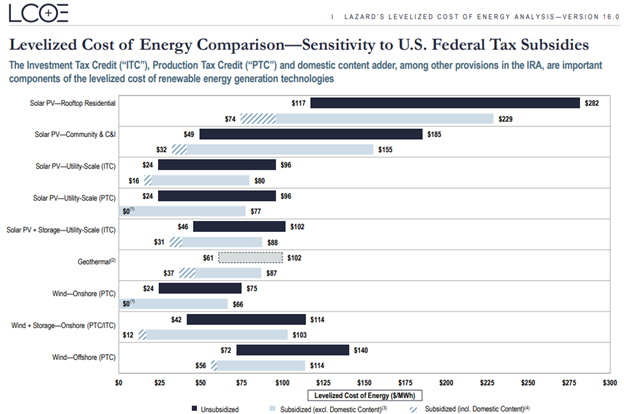What does it cost to generate solar power in Seattle? Conrad Swanson, a writer at the Climate Lab project at the Seattle Times, claims to answer that question in a recent article.However, if you read the entire article, Swanson never provides an actual price, saying only that costs for solar have come down.
If you ask someone the price of something and they only say, “its cheaper than it was,” you can be pretty sure it is still expensive. Solar in Seattle – especially rooftop solar – is very expensive.
On its web page, the members of the Climate Lab describe its mission. They write, “To meet clean-energy goals, we’ll need more transmission lines, solar arrays, windfarms and batteries throughout the West. Where these projects go and who pays for them deserves ongoing scrutiny.” The article on solar in Seattle fails to provide that scrutiny and is a good example of arguments used to justify Washington’s expensive and ineffective climate policy. The story also creates social license among policymakers to continue to subsidize technologies that are economically and environmentally wasteful.
There are five points of note in the Climate Lab piece:
- The article claims that rooftop solar makes more sense than large-scale projects which is exactly the opposite of what the data show.
- It never answers the basic question of what solar costs in Washington state compared to other options.
- Claims about solar’s affordability rely on large taxpayer subsidies - like a child claiming her lemonade stand makes money because her parents pay all the costs.
- The source for many of the claims is the head of a company that makes money from selling solar panels.
- The conclusion says that installing solar is good because it is something that people can do “today,” but there are many other things individuals can do that are less expensive and more effective.
The article correctly begins with a point we’ve made many times – “Western Washington is one of the worst places in the contiguous United States for solar energy. Perhaps even the worst place.” The evidence comes from the National Renewable Energy Laboratory’s solar irradiance map.
NREL has a solar calculator to show how much electricity is generated at different locations. A 4 kilowatt DC system on the Seattle Times building would generate an average of 3.95 kWh per square meter per day over the course of a year. In Portland, Maine, another place with very low levels of sunlight, that system would generate an average 4.65 kWh per day, about 18 percent more than Seattle. In the Tri-Cities, that same system would generate 4.95 kWh per day (25 percent more than Seattle), and in Phoenix it would generate 6.54 kWh per day, or 66 percent more than Seattle.
As Don MacKenzie, a professor at the University of Washington notes in the article, “Solar just isn’t really worth it here for bigger projects.”
Despite that data, Swanson then claims that rooftop and community solar “might make a little more sense.” To whom did he turn for this claim? He cites Reeves Clippard, the founder of A&R Solar and a board member of Washington Solar Energy Industries Association. The article explains, “Money is still a factor but Clippard, also chief strategic officer and co-founder of A&R Solar, said the cost has dropped precipitously over the past decade or so.”
It is fine to ask people in the industry about the current state of the technology, but it is important to check claims made by those with a direct financial interest against independent sources. The article didn’t do that, despite the fact that there are several independent organizations that analyze the cost of various forms of renewable energy. As a result, the article's conclusions are badly inaccurate.
 Perhaps the most commonly used study is from Lazard, an analysis firm led by Peter Orszag who served as the head of the Office of Management and Budget in the Obama Administration. Each year, Lazard releases an annual “Levelized Cost of Energy” to compare the current cost of various forms of electricity production. Their 2023 analysis found that rooftop solar is the most expensive form of renewable energy, costing up to $282 per megawatt hour (MWh), which likely reflects the cost in Seattle. Community solar is the next most expensive, with a cost of up to $185/MWh. Utility scale solar, on the other hand, is much less expensive, costing a maximum of $96/MWh. Onshore wind is even less expensive, with a maximum cost of $75/MWh.
Perhaps the most commonly used study is from Lazard, an analysis firm led by Peter Orszag who served as the head of the Office of Management and Budget in the Obama Administration. Each year, Lazard releases an annual “Levelized Cost of Energy” to compare the current cost of various forms of electricity production. Their 2023 analysis found that rooftop solar is the most expensive form of renewable energy, costing up to $282 per megawatt hour (MWh), which likely reflects the cost in Seattle. Community solar is the next most expensive, with a cost of up to $185/MWh. Utility scale solar, on the other hand, is much less expensive, costing a maximum of $96/MWh. Onshore wind is even less expensive, with a maximum cost of $75/MWh.
 Contrary to the claim by the Seattle Times Climate Lab, that rooftop solar makes more sense, it is nearly three times as expensive as utility-scale solar. Community solar is double the cost.
Contrary to the claim by the Seattle Times Climate Lab, that rooftop solar makes more sense, it is nearly three times as expensive as utility-scale solar. Community solar is double the cost.
Although the article never reveals the actual cost of solar in Western Washington, there are hints that it is expensive. It paraphrases Prof. MacKenzie saying that while rooftop solar reduces CO2 emissions, “They’re just a more expensive way to do it” than other alternatives.
The article also quotes Governor Inslee saying the state will receive $156 million from the federal government for solar projects, calling the money “heaven sent.” The article notes, “That’s also on top of federal tax credits for solar panels and any other local grants or incentives floating around.” This is lemonade stand economics – it works only if most or all of the expenses are paid by someone else. Without pennies from heaven, the bad economics of solar panels quickly catch up with the promises.
And those subsidies from the federal government aren’t free. They are paid by the taxes from people in Washington state, sent to Washington D.C. – where they take a cut – and then sent back to Washington state.
This isn’t just bad economics. It is bad for the environment. Spending hundreds of millions of dollars on technologies that yield very small reductions in CO2 emissions instead of putting those resources where they can have much more environmental benefit wastes opportunities to reduce the risk from climate change.
Politicians and activists routinely say that climate change is a crisis and that we must act now. The justification offered in the article, however, says that since someday in the future solar panels will be necessary, so we should spend limited resources on them today.
The article quotes the owner of the solar company claiming, “We are going to need more generation, that’s the flat truth.” Perhaps, but given the very high cost currently, money spent on solar now takes resources away from projects that have more immediate impact. Spending triple today for the same amount of energy that can be produced in other ways is indefensible.
The article concludes by saying installing solar panels “gives people and businesses something they can do today; it’s a chance to be part of the solution.” This ignores many other things that can be done right now and are far more effective.
If the goal is to put more renewable energy on the grid, anyone can buy renewable energy credits (RECs). Every REC purchased increases the total amount of renewable energy that is generated by one MWh. State law requires utilities to offer RECs. You can also buy them from the Bonneville Environmental Foundation (BEF). Notably, RECs from the Pacific Northwest cost $15 per MWh, but those from sources across North America cost only $8 per MWh. The planet doesn’t care where the renewable energy is from, but it is another piece of evidence that renewable energy, like solar, costs much more in the Pacific Northwest.
The fact that putting solar panels in Western Washington is extremely expensive is not a surprise to experts at the National Renewable Energy Laboratory or organizations like Lazard who look at the data.
Politicians, activists, and the public, on the other hand, are often surprised to find out how ineffective and wasteful solar energy production is in the Seattle area. Articles purporting to offer scrutiny to climate policy, but instead offer justifications for wasteful policies and obscure alternatives that are more effective and accessible, are one reason so many people don’t understand the true costs.
Instead of checking the facts offered by industry advocates who benefit financially from government subsidies, their claims are taken at face value.
Washington’s climate policy has been extremely ineffective over the past decade and until there is accountability and an honest assessment of what works and what doesn’t, politicians will continue waste time on money and the environment will continue to pay the price.




